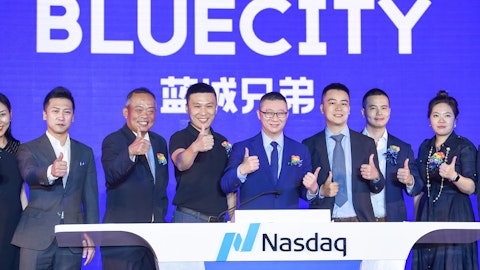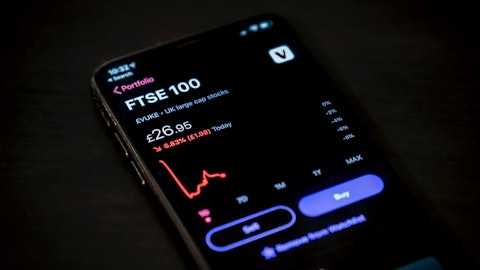Sprinklr, Inc. (NYSE:CXM) Q4 2023 Earnings Call Transcript March 29, 2023
Operator: Ladies and gentlemen, thank you for standing by, and welcome to Sprinklr’s Fourth Quarter Fiscal 2023 Earnings Conference Call and Webcast. At this time all participants are in a listen-only mode. After the speakers’ remarks, there will be a question-and-answer session. Please limit your questions to one with one follow up, so we will have time to go through all the questions. Please be advised that today’s conference is being recorded. I’d now like to hand the conference over to your first speaker today, Mr. Eric Scro, Vice President of Finance, for introductory remarks. Please go ahead, Eric.
Eric Scro: Thank you, Kevin, and welcome, everyone, to Sprinklr’s fourth quarter and fiscal year 2023 financial results call. Joining us today are Ragy Thomas, Sprinklr’s Founder and CEO; and Manish Sarin, Chief Financial Officer. We issued our earnings release a short time ago, filed the related Form 8-K with the SEC, and we’ve made them available on the Investor Relations section of our website, along with the supplementary investor presentation. Please note that on today’s call, management will refer to certain non-GAAP financial measures. While the company believes these non-GAAP financial measures provide useful information for investors, the presentation of this information is not intended to be considered in isolation or as a substitute for the financial information presented in accordance with GAAP.
You are directed to our press release and supplementary investor presentation for a reconciliation of such measures to GAAP. In addition, during today’s call, we will be making forward-looking statements about the business and about the financial results of Sprinklr that involve many assumptions, risks and uncertainties, including our guidance for the first fiscal quarter of 2024 and full fiscal year 2024, and our actual results might differ materially. Any forward-looking statements that we make on this call are based on our beliefs and assumptions as of today, and we disclaim any obligation to update them. For more details on the risks associated with these forward-looking statements, please refer to our filings with the SEC also posted on our website.
With that, let me turn it over to Ragy.
Ragy Thomas: Thank you, Eric, and hello, everyone. I hope everyone is doing well, and thank you for joining us today. We’re going to share quite a few exciting updates today, so let’s get right to it. I am very pleased that Q4 was another strong quarter that exceeded guidance across all key metrics. Q4 total revenue grew 22% year-over-year to $165.3 million and subscription revenue grew 26% year-over-year to $148.3 million. With our continued commitment to operational efficiency, we generated a record $14.3 million in non-GAAP operating income for the quarter due to strong revenue growth and greater operational discipline company-wide. While we expect the sales cycles to remain elevated in FY 2024, we did have a record number of new bookings due to strong expansion deals and exciting new logo growth.
Our growth retention was on par with leading enterprise software companies, and we saw continued strong momentum in our Sprinklr Service suite formerly known as Modern Care. Sprinklr Service represented over 40% of our new bookings for the quarter. Let’s start with the go-to-market. On the go-to-market front, we believe that spending environment was largely unchanged in Q4 compared to previous quarters. But we are increasingly confident that the changes we are making and its impact on our business and our ability to execute. Our focus, as you know, has been on making it easier to sell Sprinklr. Here are a few examples of the work that is underway. We added dedicated Sprinklr Service specialists. We created a dedicated team of new logo sales reps.
We’re leveraging partners now to act more as deal sourcers rather than just deal influencers. We are in the process of developing our verticalized solution-based selling approach as opposed to a product-based approach. And we are moving to a productivity-driven sales model as opposed to just pure capacity-based sales marking. I also want to share the progress that we’ve seen from our expanded partnerships with Salesforce and Accenture that we talked about last quarter. We continue to win enterprise deals with customers transitioning out of social studio. One of those deals, for example, in Q4 led to a seven-figure multiyear contract with a leading global CPG company. Our deep expertise in social combined with the new AI innovations and integrations are just a few reasons why we believe that Sprinklr will continue to remain the leader in enterprise social media management.
There are several exciting announcements on the platform side. To start with, we renamed our product suite this quarter to simplify them and to align them with our longer-term strategy to mainstream each one of them. We believe this provides better clarity for our customers and reflects the market categories they belong to more accurately to drive awareness and brand recognition in the marketplace. Modern Care is now Sprinklr Service aligned with the CCaaS market, Social Engagement and Sales is now simply Sprinklr Social, Modern Marketing and Advertising is now Sprinklr Marketing, and Modern Research is now Sprinklr Insights. And finally, our Lite portfolio as we roll out more self-service capabilities will now just be referred to as self-service.
Next, let’s take a deeper dive into Sprinklr Service and why we are seeing success as a radical disruptor in the CCaaS space. Sprinklr Service is a comprehensive AI-powered contact center as a service platform. We are transforming the contact center from an old voice-based cost center to an omnichannel revenue center by unifying marketing and sales for more efficient service and growth for the business. And with Sprinklr Insights, as you know, we have the unique ability to harness publicly available digital data in addition to traditional call transcripts to quickly identify top service issues and reduce overall ticket volume coming in. Our pace of innovation in this space continues as highlighted in our recent announcement of over 100 features that we have added to our service offering, notably predictive intelligence, AI-based quality management and outbound voice dialing.
According to a recent Gartner report, $800 billion is going to be spent annually on contact center labor costs €“ technology and labor. We all know that AI is going to optimize this fairly dramatically. Now it might surprise you to know that today, Sprinklr supports on our platform, 75,000 call center agencies with 30 new deployments happening with large brands around the world as we speak. In FY 2023, we had 11 1 million or more deals in our service suite alone. And just a few weeks ago, we were named a challenger in the Gartner Magic Quadrant for Enterprise Conversational AI Platforms. Let’s switch gears to social now. We are very excited to announce the self-service version of our industry-leading social media management institution called Sprinklr Social.
Social media teams can now access Sprinklr Social on a self-service basis for publishing, engagement and reporting. It’s also integrated with OpenAI’s generative AI models to create better content faster and with fewer resources. This out-of-the-box product is simpler, smarter, and better than any other competing social media management tool available in the market today. The self-service and enterprise version of Sprinklr Social like with Sprinklr Service before are both on the same backend code base, which means that teams can start with a self-service version and seamlessly opt for the enterprise offering as their needs grow. Let’s talk about AI, which I know is quite a popular topic these days. Five years ago back in 2018, we issued a press release describing how Sprinklr was the only enterprise software provided in the front office that gives brands the capabilities to reach, engage, and listen to their customers across a growing number of digital channels.
So it’s not a new buzz word for us. Our entire Unified-CXM platform and every one of our four robust products suite was built from the ground up with our proprietary AI capabilities. I want to make it clear that in building Sprinklr, we took an operating system approach to our platform, which makes it very easy for us to integrate with any existing or new software product when and where it upgrades our own capabilities. This is one of the reasons we are so excited about our integration with OpenAI. There’s a massive potential and a big market transition happening with generative AI, and we see the potential of how we can work together to truly revolutionize front office for our mutual customers. AI and machine learning will continue to be a cornerstone and a competitive advantage for Sprinklr, and we will play our part to help mainstream AI across all customer facing functions of large companies.
We look forward to further integrating OpenAI across our entire platform and in all our products suite. Turn to some customer stories, during the fourth quarter, we continue to add new customers and expand with existing customers. This includes world-class brands like AT&T, Activision, IKEA, Mars, Prudential, and Telefonica. Here are some examples of how customers are currently using Sprinklr. Let’s start with Sprinklr Service, our omni-channel customer service solution. Last year, we were chosen to support the large scale CCaaS transformation of one of the largest banks in the world HDFC. We’ve replaced more than 10 point solutions and onboarded over 10,000 agents, including inbound and outbound voice, text, social, and messaging. Our platform now supports more than 5 million interactions on text based channels every month and more than 12 million voice calls.
With a strong focus on AI and unification across channels and teams, we’ve also launched the bank’s first voice bot and conversational chat bots. Our AI is able to resolve 70% of customer inquiries and has reduced the average case handling times across all channels by 15%. HDFC has reduced the first response time by more than 50%, 5-0, and Sprinklr is now integrated with eight of the bank’s backend systems across 100 customer journeys, making Sprinklr the single screen for most users and enabling them to provide a consistent and seamless experience to its 71 million customers. Last quarter, we shared a big win in the CCaaS space with one of the world’s leading global streaming media companies. This quarter, I’m pleased to announce that they’ve expanded the partnership with Sprinklr Marketing.
The company is consolidating 15 disparate solutions and its entire global marketing team of more than 700 users in 30 countries onto Sprinklr Marketing with a clear real-time view of paid, owned, and earned media performance, the company’s marketing team can make faster, more collaborative and data driven creative and media investment decision. Sprinklr’s AI powered insights will enable them to increase their reach, optimize their creative assets, and drive excitement in the market around their title releases. The next example is my favorite, and it demonstrates the true transformational power of the unified customer facing in front of this platform. In the very first of its kind for any country that we know of the Civil Services and Government Development Bureau of Qatar selected Sprinklr as its technology partner to transform how the government provides services to and engages with the public.
Qatar National Vision for 2020 is focused on building a competitive government with the ability to measure, monitor, and improve its public services. The government aims to meet the demands of Qatari citizens and residents for fast personalized interactions with government agencies on any communication channel, which Sprinklr, Qatar will now eliminate several fragmented technology solutions and unify approximately 40 public service agencies onto one unified citizen experience management platform. This enables obviously the seamless delivery of omni-channel experiences to its citizens, residents, and visitors. I’d like to take a moment to celebrate our incredible engineering team who makes all of this possible. They continue to innovate at a breakneck pace that differentiates us in the big way in the market.
In closing, I’d like for you to have three clear takeaways. Number one, we’re going to be a disruptive player in CCaaS. That’s a pretty 30, 40-year old industry. We are a digital native company who has created a modern omni-channel approach to integrating 30 plus digital channels that now includes voice, and we’re challenging some of the well-known legacy players with an entirely different approach omni-channel and AI base for customer service. Number two, we will continue to innovate and win in social. It’s where we started as a company and that foundation has enabled us to build disruptive new opportunities like we are doing in CCaaS. And lastly, number three, we are well-positioned to begin mainstreaming our solutions and AI for customer facing functions.
We have a five-year head start and advantage in building proprietary AI that’s integrated into all products across our entire platform, a platform that’s built on a highly open, scalable, and flexible architecture. This is a great competitive advantage, because it offers our customers a way to connect to any homegrown or in-house systems they build or any other industry solution in the marketplace. I want to thank our customers, partners and most importantly today, our employees for their incredible hard work in Brazil. I also want to thank all of you and our investors for believing in the vision. Let me hand the call over to Manish.

Photo by Austin Distel on Unsplash
Manish Sarin: Thank you, Ragy, and good afternoon, everyone. As you heard from Ragy, FY2023 was a stellar year for Sprinklr, which we capped off with a strong Q4 that once again exceeded expectations. In fact, during the fourth quarter, we achieved quarterly records in gross new bookings, total billings, total revenue, gross margin, and non-GAAP operating income. Many of the tailwinds that Ragy mentioned coupled with Sprinklr’s leading artificial intelligence and product development capabilities really excited me about the company when I joined a year ago. But we also uncovered several areas in need of structural improvements and we have been executing on these initiatives for the last several quarters. During FY2023, we pivoted towards a productivity led model, eliminated projects that were not yielding an attractive ROI, and as Ragy discussed, we made a deliberate effort to make it easier to sell Sprinklr.
You saw the fruits of our efforts play out throughout the year as demonstrated by sequential growth in subscription revenue, the stability in absolute non-GAAP operating expenses, our ability to generate free cash flow and our reported non-GAAP operating income in both Q3 and Q4. These results were driven by a conscious effort to be more efficient and develop a culture of good corporate hygiene and financial prudence. In line with this, we recently concluded an internal review across product areas, regions, and support functions to help us grow and scale the business and to ensure our resources are best aligned with Sprinklr’s priorities moving forward. As a result of this review, we restructured our global workforce by approximately 4% back in February.
Expenses related to this action were approximately $4 million and will be booked here in Q1 FY2024. These expenses are included in the guidance I will discuss in greater detail later in my prepared remarks. Turning now to our Q4 financial results. Total revenue was $165.3 million, up 22% year-over-year and above the high end of our guidance range. This was driven by subscription revenue of $148.3 million, which grew 26% year-over-year also above the high end of our guidance range. Our subscription revenue continues to accelerate in terms of both absolute dollars and growth rate. In the fourth quarter, the sequential increase in subscription revenue was $8.4 million, a meaningful uptick when compared to the increases in Q2 and Q3. Services revenue for the quarter came in at $17 million.
As noted on the third quarter earnings call, this was driven by a focus on margins for our services business as we have been thoughtful about not taking on lower margin services business. We will continue to actively manage our professional services margins, which will impact the absolute level of our professional services revenue going forward, something that I will cover in detail later in my prepared remarks. Our subscription revenue based net dollar expansion rate in the fourth quarter was 124%. Our gross renewal rate in Q4 was again on par with leading enterprise software companies. We believe this high renewal rate, coupled with the expansions in our installed customer base is a testament to how important Sprinklr is to our customer’s daily workflows and how our customers view Sprinklr as a platform to standardize on.
As of the end of the fourth quarter, we had 108 customers contributing $1 million or more in subscription revenue over the proceeding 12 months, which is a 32% increase year-over-year. As a reminder, we calculate this customer count using $1 million in recognized revenue from these customers on a trailing 12-month basis as opposed to ARR. Regarding our total customer count, we ended the fiscal year with 1,428 customers, which is a 22% increase in new customers for the year. Turning to gross margins for the fourth quarter. On a non-GAAP basis, our subscription gross margin was a record 83% as we continue to drive efficiencies in our cloud operations, leading to a total non-GAAP gross margin of 77%, another record for us here at Sprinklr. We have posted steady and consistent improvement in our non-GAAP subscription and total gross margin every quarter in FY2023.
We also reported continued steady improvement in our professional services, non-GAAP gross margin in the fourth quarter, which came in at approximately 22%. We continue to generate efficiencies in sales and marketing and have shown consistent improvement in S&M spend throughout the year. Sales and marketing expenses in the fourth quarter are now 45% of revenues compared to 56% this time last year. This is a 1,100 basis point decrease year-over-year. We also realized operating leverage from G&A, which decreased by 60 basis points year-over-year. Turning to profitability for the quarter. Non-GAAP operating income was a record $14.3 million equating to a non-GAAP net income of $0.06 per share. This 9% operating margin for the quarter was a result of revenue over performance, improved gross margins coupled with operating expense discipline across every department.
This quarter’s non-GAAP operating margin compares very favorable €“ favorably to the negative 8% operating margin in the fourth quarter of last year. To that end, in terms of free cash flow, we generated $16.3 million during the fourth quarter compared to a burn of $18 million in the same period last year. Calculated billings for the fourth quarter were $232.2 million, an increase of 25% year-over-year, and a billings record for Sprinklr. And just as a quick reminder, our fourth quarter billings have historically been the largest for us given the timing of our renewals. Turning to a quick summary of financial results for the full year FY2023, a year in which we posted material improvements and strong growth across the board, including total revenue, gross margins, non-GAAP operating income, free cash flow, and our key performance indicators.
Total revenue was $618.2 million, up 26% year-over-year, and subscription revenue was $548.6 million, up 28% versus the prior year. Calculated billings for the full year were $659.3 million, up 23% year-over-year. I’m happy to say that we posted non-GAAP operating income for the full year of $6 million, equating to a non-GAAP net income per share of $0.01 and a non-GAAP operating margin of 1%. Our non-GAAP operating income improved by $41.5 million over FY 2022, which coupled with the incremental $125.8 million in revenue, demonstrates the inherent operating leverage in our business and computes to an incremental operating margin of approximately 33%. In terms of free cash flow, we generated $22.2 million in adjusted free cash flow for the year compared to a burn of $45.3 million in FY 2022.
This is a $67 million improvement in free cash flow generation in just one year. This cash flow generation contributed to our very healthy balance sheet, including $579 million in cash and investments and no debt. A quick side note on Silicon Valley Bank, SVB, our exposure to SVB is immaterial and our cash balances are held at other large well capitalized financial institutions. We have a $50 million credit facility with SVB that we are currently in the process of terminating. As of the end of FY 2023, total remaining performance obligations or RPO, which represents revenue from committed customer contracts that has not yet been recognized was $719.5 million, up 26% compared to the same period last year. And cRPO was $485.2 million, up 23% year-over-year.
We continue to believe that subscription revenue, subscription revenue growth, RPO and RPO growth represent the best metrics to evaluate the underlying health of the business. Our billings can fluctuate significantly relative to revenue based on the timing of invoicing, cadence of renewals, and the duration of customer contracts. Moving now to our Q1 and full year FY 2024 guidance and business outlook. As you heard today, long-term demand trends and engagement for Sprinklr remains strong. We are encouraged by the leading indicators coming out of the fourth quarter and the momentum we have across our business, especially Sprinklr service. We recognize that the macroeconomic environment continues to be uncertain and volatile, and our current assumption is that the broader macro trends from the last few quarters are likely to continue through FY 2024.
For Q1 FY 2024, we expect total revenue to be in the range of $168 million to $170 million, representing 17% growth year-over-year at the midpoint. Within this, we expect subscription revenue to be in the range of $153 million to $155 million, representing 21% growth year-over-year at the midpoint. We expect non-GAAP operating income to be in the range of $3 million to $5 million and non-GAAP net income per share of breakeven to $0.01 per share, assuming 268 million weighted average shares outstanding. Recall, as part of the restructuring exercise concluded here in Q1, we spent approximately $4 million, which is included in the above numbers. Said differently, excluding this charge, non-GAAP operating income would have been in the range of $7 million to $9 million.
For the full year FY 2024, we expect subscription revenue to be in the range of $644 million to $648 million, representing 18% growth year-over-year at the midpoint. We expect total revenue to be in the range of $710 million to $714 million, representing 15% growth year-over-year at the midpoint. For modeling purposes, assume the quarterly revenue numbers follow the same distribution as FY 2023. These guidance ranges imply a services revenue of $15 million for Q1 and $66 million for full year FY 2024. For modeling purposes, assume $30 million in services revenue for the first half and $36 million in the second half. We expect services revenue to decline marginally in both Q1 and full year FY 2024 for all the reasons we have been discussing over the last few quarters.
In addition, we expect the services makes to migrate more towards managed services, which carries a higher margin. As a result of this migration, we will be hiring more managed services consultants in the first half of FY 2024, which will depress services margins in the first half to breakeven before picking back up to approximately 15% for the second half of the year. For projecting billings for both Q1 and full year FY 2024, it would be prudent to assume that billings growth tracks revenue growth for the full year. This implies total billings for FY 2024 of $759 million. For modeling purposes, this total billings number should be spread across the arc of the four quarters, largely following the same trend as FY 2023. As I had stated earlier, we have been working on migrating customer billings to an annual billing cycle and have begun to see the early results of that effort, improving billings growth and narrowing the historical 5% gap between revenue growth and billings growth.
For full year FY 2023 €“ 2024, we estimate non-GAAP operating income to be in the range of $41 million to $45 million, equating to a non-GAAP net income per share of $0.13 to $0.15, assuming 273 million weighted average shares outstanding. This implies a 6% non-GAAP operating margin at the midpoint. In deriving the net income per share for modeling purposes and $11 million total tax provision for full year FY 2024 needs to be added to the non-GAAP operating income range just provided. We estimate a tax provision of $2.5 million here in Q1. We also expect to be solidly free cash flow positive on a full year basis and to generate positive net income for the full year on a GAAP basis, which would be the first time ever. Lastly, I would like to thank all our employees for their dedication, delivering a record quarter for Sprinklr, and for closing the year strong.
During an uncertain macro environment and continued volatility in the financial markets, I’m also grateful for the confidence that our customers have placed in us. We remain focused on building a track record of successful execution and operating discipline across the business. And with that, let’s open it up for questions. Operator?
See also 11 Most Promising Clean Energy Stocks and 17 Best Gambling Stocks to Buy Now.
Q&A Session
Follow Sprinklr Inc.
Follow Sprinklr Inc.
Operator: Thank you. Our first question today is coming from Raimo Lenschow from Barclays. Your line is now live.
Unidentified Analyst: Hi. This is Isaac on for Raimo. Thanks for taking the question. I wanted to talk a little bit about NRR and the moving pieces there. When thinking about the drivers of this, how should we think about seats versus more modules and functionality? And as we look to FY 2024, are there any considerations we should note between these two drivers? Thank you.
Manish Sarin: Hi. This is Manish. Thank you for the question. What we have said before is two-thirds of our new business comes from existing accounts through upsells, and that can be a mix of whether it’s more seats, more modules, more product suites, and it’s a combination of all three. There isn’t any discernible difference. And as we look at bolting on more ARR into the business from our perspective, all those things add more revenue and more opportunity set into the account base. And I think those trends are to continue. So, which is part of the reason you would notice total customer account increased only 22% going from 1,166 last year to 1,428 at the end of FY 2023. But our accounts with more than $1 million in revenue increased 32%.
So I think that trend probably will continue through FY 2024. We are obviously making several initiatives, as Ragy mentioned earlier, around increasing more logos into the business. But for right now, I think that would be a safe place to start.
Unidentified Analyst: Great. Thank you.
Operator: Thank you. Next question is coming from Brett Knoblauch from Cantor Fitzgerald. Your line is now live.
Brett Knoblauch: Hi, guys. Thanks for taking my questions. On the quarter, it seems like you guys saw very good momentum on the new customer addition front in the year. I guess as we look at next year, should we expect maybe the contribution to maybe subscription revenue or billings or however you want to look at it from new customers added to the €“ a bit greater than maybe what we saw this year. And maybe on a total new customer ad perspective, should we expect something similar to this year or do you expect that metric to kind of continue to increase given what you guys are doing on the self-service side? Thank you.
Ragy Thomas: Yes, Brett. This is Ragy. Let me take a crack at it. We don’t anticipate a big shift in the mix. As we outlined before, our strategy with self-service is to just go after our target account list, which is about 43,000 companies and just give them a way to get started to try our product before they have to contact sales and get a feed for what the platform does. So we don’t €“ while we going to have a little more renewed and dedicated focus, that’s something we’ve been trying to do. So there’s really not a big focus on customer logos as much as there’s a focus on growth in ARR.
Brett Knoblauch: Perfect. Thank you. And then maybe just one clarification question on RPO or total RPO and current RPO growth. I guess the year-over-year growth numbers I have were total of 22.7 and current of 18.6. And I believe that’s all a 409.24 for current, 586.4 for last year which was in your press release last year. So I guess, am I using the wrong numbers there for the compare period?
Manish Sarin: Yes, this is Manish. So, I think you’ll see this detailed in the 10-K that’s going to be filed on Monday. The numbers that you’re using for RPO and cRPO now are slightly different from what was released in the prior year results. And as part of our SOX compliance this year, as a first year public company, we’ve gone ahead and really looked at contracts all the way back to 2013, and we found that there were a handful of contracts from 2014 that had a term for convenience. The customers have obviously been with us since 2014, but accounting rules would prevent us from including that in the RPO. So we’ve had to make a small adjustment. So you should go with the numbers that are now placed in the press release versus the numbers in the prior earnings releases. Does that make sense?
Brett Knoblauch: Yes, it does. Appreciate the color there. Thanks, guys.
Operator: Thank you. Next question today is coming from Pinjalim Bora from JPMorgan. Your line now live.





